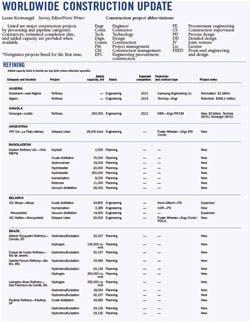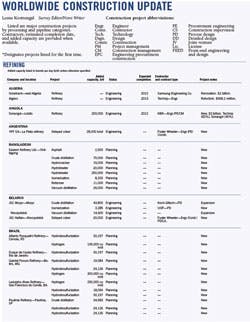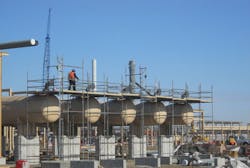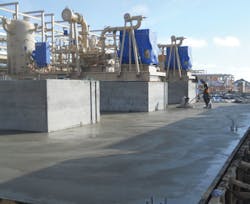Oil & Gas Journal's semiannual Worldwide Construction Update shows an increase in refining construction activity compared with the previous edition of the update (OGJ, Nov. 7, 2011, p. 28). Following are details from the latest survey, which is available on OGJ Online (see box).
Refining
In March, Essar Oil Ltd. completed the $1.81 billion expansion of its Vadinar refinery in India with the successful commissioning of the 7.5 million tonne/year delayed coker unit, the final unit to be completed (OGJ Online, Mar. 30, 2012).
The refinery expansion project was implemented using Essar Group's in-house capabilities. The construction and overall project management was handled by Essar Projects. The DCU, which is among the world's largest units of its type, is a key addition to Vadinar because of its ability to convert bottom-of-the-barrel vacuum residue into gas oil, gasoline, and vacuum gas oil.
New units include a 3.9 million tpy fluidized catalytic cracking unit, 0.7 million tpy isomerization unit, 4 million tpy diesel hydrotreater, 6.5 million tpy vacuum gas oil hydrotreater, and 675 tonne/day sulfur recovery unit. An optimization project is also under way at the Vadinar refinery that will further increase the capacity to 405,000 b/d by September.
Also in India, HPCL-Mittal Energy Ltd. has commissioned its 180,000-b/d, zero-bottoms Guru Gobind Singh Refinery near Bathinda in the northern Indian state of Punjab (OGJ Online, Mar. 29, 2012).
The grassroots refinery has been running crude oil since last August, but commissioning of the full facility was delayed until Mar. 29 (OGJ Online, Nov. 2, 2011). Processing capacities include delayed coking, fluid catalytic cracking, and continuous catalytic reforming.
Petron Corp. Mandaluyong City, Philippines, let contracts for two conversion units in a major upgrade of its 180,000 b/d refinery at Limay, Bataan, about 150 km southwest of Manila (OGJ, Jan. 27, 1997, p. 74; OGJ Online, Jan. 17, 2012).
A unit of Foster Wheeler's Global Engineering & Construction Group will conduct detailed engineering and procurement services for a 37,500 b/sd delayed coker and engineering and material supply for two coker heaters. Foster Wheeler handled process design and proprietary technology for the coker.
OGJ subscribers can download free of charge the 2012 Worldwide Construction Update tables at www.ogjonline.com: Click on OGJ Subscriber Surveys, then Worldwide Construction. This link also includes previous editions of the update. Historical spreadsheets of data presented here are available for purchase from PennEnergy Research. Visit www.ogj.com, and click the "Research" tab.
Earlier, Petron let a contract to Axens to supply technologies for a 15,700 b/sd mild hydrocracker, 35,900 b/sd fluid catalytic cracker, 19,000 b/sd C4 cut purification system, C4 olefins oligomerization unit, two FCC gasoline selective desulfurization units with capacities of 8,000 b/sd and 17,600 b/sd, a 5,800 coker naphtha hydrotreater, and unsaturated LPG treatment units with capacities of 25,000 b/sd and 3,600 b/sd. The process scheme will maximize production of propylene from the FCC at more than 250,000 tpy.
Daelim Industrial of South Korea has an engineering, procurement, and construction contract for the overall project, which it estimates in value at $2 billion.
Meanwhile, Thailand's IRPC PLC let contracts to Shaw Group Inc. to provide process design and technology license to add a 30,000-b/d deep catalytic cracking unit at IRPC's 215,000-b/d refinery in Rayong (OGJ Online, Mar. 12, 2012). No contract value or timetable was divulged.
The upgrade project will "maximize production of polymer-grade propylene and recovery of polymer-grade ethylene for feedstock for petrochemical derivative units at the same site," Shaw Group said. It also said the company would function as the "superlicensor" for four additional supporting technologies provided by Axens.
Petrochemical
Samsung Total Petrochemicals is building aromatics and ethylene-vinyl acetate copolymer units at its Daesan petrochemical complex in Chungnam Province, South Korea. (OGJ Online, Jan. 27, 2012).
The complex, which processes naphtha, now has 13 plants producing a range of polymers and fuels. Its ethylene capacity is 1 million tpy.
The aromatics unit will have production capacity of 1 million tpy of paraxylene and 420,000 tpy of benzene. After its completion in 2014 and following an upgrade of the existing aromatics plant, total paraxylene production capacity of the complex will be 1.76 million tpy. Capacity of the new ethylene-vinyl acetate copolymer unit will be 240,000 tpy.
South African energy and chemicals company Sasol reported it has approved a feasibility study for a world-scale ethylene cracker and derivatives complex in Lake Charles, La. (OGJ Online, Nov. 30, 2011).
The company envisions the cracker will produce 1-1.4 million tpy of ethylene. Its current estimates are that a cracker and derivatives complex will cost $3.5-4.5 billion. The feasibility study is to be completed during first-half 2013.
In March, Egyptian Ethylene & Derivatives Co. let a contract to Toyo Engineering Corp. and ENPPI to build a 460,000 tpy ethylene plant and a 20,000 tpy butadiene extraction plant as part of Ethydco's petrochemical complex to be established in Alexandria, the Arab Republic of Egypt.
Toyo and ENPPI will execute the EPC and commissioning under a lump-sum turnkey contract. Toyo will lead the entire project execution, undertaking project management, basic engineering, a part of detailed engineering, and procurement of key equipment.
ENPPI will be in charge of joint project management, detailed engineering and procurement of other equipment and materials. Both companies will execute the construction and commissioning in collaboration with Petrojet, an Egyptian construction company as a subcontractor. The contract amount is about $600 million and the plant is scheduled for start-up in early 2015.
LNG
In the US, the Gulf LNG terminal began at the end of October 2011 in Pascagoula, Miss. The terminal is equally owned by GE Energy Financial Services and El Paso Corp., Houston. A subsidiary of El Paso will operate the 5 million tpy terminal (OGJ Online, Oct. 28, 2011).
It consists of two 160,000-cu m storage tanks with combined capacity of 6.6 bcf; 10 vaporizers, providing a base sendout capacity of 1.3 bcfd; and 5 miles of 36-in. pipeline connecting to downstream pipelines owned by Gulfstream, Destin, Transco, and Florida Gas Transmission.
In other LNG news, Indian Oil Corp. Ltd. has let a contract to Foster Wheeler AG's Global Engineering & Construction Group for work on an LNG terminal to be built at Ennore in Tamil Nadu, India (see map, OGJ, June 19, 2000, p. 62; OGJ Online, Jan. 19, 2012).
The terminal will have a design capacity of 5 million tpy. State-owned IOCL expects start-up in 2015-16. The Foster Wheeler unit will handle basic design, front-end engineering design, and preparation of capital and operating cost estimates. The firm also will include marine studies to help IOCL determine final jetty location, utilities, and send-out facilities.
Malaysia's Petronas will add a ninth LNG train to its Bintulu, Sarawak, complex on Borneo. The train with have a nameplate capacity of 3.6 million tpy and bring total capacity at the site to 27.6 million tpy (OGJ Online, Feb. 24, 2012).
Offshore fields in Sarawak will produce feed gas for the new train up to 850 MMcfd. Plant start-up targets fourth-quarter 2015.
Petronas awarded a front-end engineering and design contract to JGC Corp. and to a joint venture between Japan's Chiyoda Corp. and Italy's Saipem. The engineering, procurement, and construction contract for the new train will be awarded to one of these two entities upon completion of the FEED.
Natural gas
Oil Industries Engineering and Construction Co., has signed a $1.4 billion contract with the National Iranian Oil Co. to build the country's largest natural gas to liquids plant. The NGL plant will have the capacity to turn 270 MMcf of gases associated with oil into liquids per day.
The plant is projected to come on stream within 44 months. It will produce 46,000 b/d of ethane as well as 79 MMcfd of methane, according to the Pana news agency.
Petroleo Brasileiro SA (Petrobras) let a contract to Exterran Holdings Inc. for the design, fabrication, and sale of a major natural gas processing and treating facility in Itau, Bolivia.
The facility is a dew point gas plant that can process 200 MMcfd and is expected to start up in 2013. Exterran is the primary contractor on the project, providing equipment, engineering, procurement, and construction products and services, and project management.
The project is Exterran's largest gas processing facility by capacity in Latin America.
Other gas, sulfur
Uzbekistan GTL LLC has extended an existing services contract of Technip for front-end engineering design of a gas-to-liquids plant 40 km south of Qarshi in Uzbekistan (OGJ Online, Mar. 8, 2012).
This plant will be based on Sasol's GTL technology and be able to produce up to 1.4 million tpy, a capacity similar to the Oryx GTL plant in Qatar, also implemented by Technip. The Uzbekistan plant will have the following product slate: GTL diesel, kerosene, naphtha, and LPG.
This award follows the successful execution by Technip of the first-phase contract related to the detailed feasibility study (OGJ, Mar. 15, 2010, Newsletter). The FEED activities will be executed by Technip's operating center in Rome with the support of the group's center in Kuala Lumpur.
Meanwhile, Petrogal SA completed a sulfur project in Porto. It will process 27 tonnes/day of sulfur from refinery acid gas.
Pipelines
Oneok Partners LP plans to build a 270-mile natural gas gathering system and related infrastructure in Divide County, ND. The system, expected to be completed second-half 2013, will gather and deliver gas from producers in the Bakken shale to the partnership's previously announced 100-MMcfd Stateline II gas processing facility in western Williams County, ND (OGJ Online, Apr. 4, 2012).
Oneok is expanding its Bakken shale activities, investing $1.5-1.8 billion between 2011 and 2014 in its gas gathering and processing and NGL businesses in the region with the $140-160 million it expects to spend on the Divide County system coming in addition to these expansions.
Previously announced projects include the 500-mile NGL Bakken Pipeline and three 100-MMcfd gas processing facilities: the Garden Creek plant, Stateline I plant, and Stateline II plant. Garden Creek entered service December 2011. Oneok expects Stateline II to enter service first-half 2013.
Meanwhile, SemGroup Corp., Gavilon Group LLC unit Gavilon Midstream Energy LLC, and a unit of Chesapeake Energy Corp. plan to form a joint venture to build a 210-mile pipeline in western and north-central Oklahoma. The line will transport oil to a 1 million bbl storage facility in Cushing.
The pipeline will consist of two laterals, one starting near Alva in Woods County, Okla., and the other near Arnett in Ellis County, Okla. The laterals will intersect near Cleo Springs in Major County, Okla., where the pipeline will increase in diameter and continue east to storage at Cushing.
The pipeline will have an initial capacity of 140,000 b/d, expandable to 180,000 b/d through additional horsepower. SemGroup will design, build, and operate the pipeline; Chesapeake is the project's anchor shipper; and Gavilon will perform risk management and clear the shipped crude in the Cushing market.
The companies plan to begin building the pipeline in July for an in-service date of third-quarter 2013.
Energy Transfer Partners LP has let a contract to a unit of Willbros Group Inc.'s oil and gas segment for the construction of a portion of its Red River Gathering Pipeline (OGJ Online, Apr. 3, 2012). The scope of work includes construction of 97 miles of 30-in. OD pipeline from Ardmore, Okla., to Denton, Tex.
Red River, which also includes 10 miles of 24-in. OD line, starts in Carter County, Okla., and will have an initial capacity of 450 MMcfd, with anticipated capacity expansion to beyond 550 MMcfd. ETP expects the pipeline to enter service in the fourth quarter.
More Oil & Gas Journal Current Issue Articles
More Oil & Gas Journal Archives Issue Articles
View Oil and Gas Articles on PennEnergy.com





